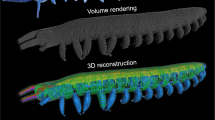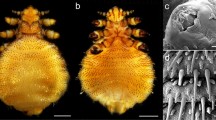Abstract
A THOROUGH investigation of the ultramicroscopic structure of the frog's heart performed on animals suffering from red-leg disease led to the discovery of very small parasites in the blood-stream and also in the cardiac tissue of two such animals. They accumulated mainly in the sub-endocardial space, that is, the space between the ultra-thin layer of spreading endocardial cells and the sarcolem of muscle fibres. In this space, as previously shown, individual cells, collagen fibres and nerve axons are usually found. The parasites found there in great amounts are a hitherto unknown type of protozoa. The biggest individual specimen found to date measures about 10µ There are mainly three forms: (1) a pyriform, the biggest of these specimens measured 3µ, having one cilium on its tip; (2) a spindle- or sausage-shaped appearance, having a size of 2–5µ and one cilium on each end; (3) a bizarre type of amœboidal appearance, the biggest of these being up to 10µ in size. They have cilia in irregular distribution stemming from the body.
This is a preview of subscription content, access via your institution
Access options
Subscribe to this journal
Receive 51 print issues and online access
$199.00 per year
only $3.90 per issue
Buy this article
- Purchase on Springer Link
- Instant access to full article PDF
Prices may be subject to local taxes which are calculated during checkout
Similar content being viewed by others
References
Kisch, Bruno, Exp. Med. and Surg., 19, 85 (1961).
Author information
Authors and Affiliations
Rights and permissions
About this article
Cite this article
KISCH, B. A New Type of Cardiac Parasite. Nature 194, 102–103 (1962). https://doi.org/10.1038/194102b0
Issue Date:
DOI: https://doi.org/10.1038/194102b0
Comments
By submitting a comment you agree to abide by our Terms and Community Guidelines. If you find something abusive or that does not comply with our terms or guidelines please flag it as inappropriate.



